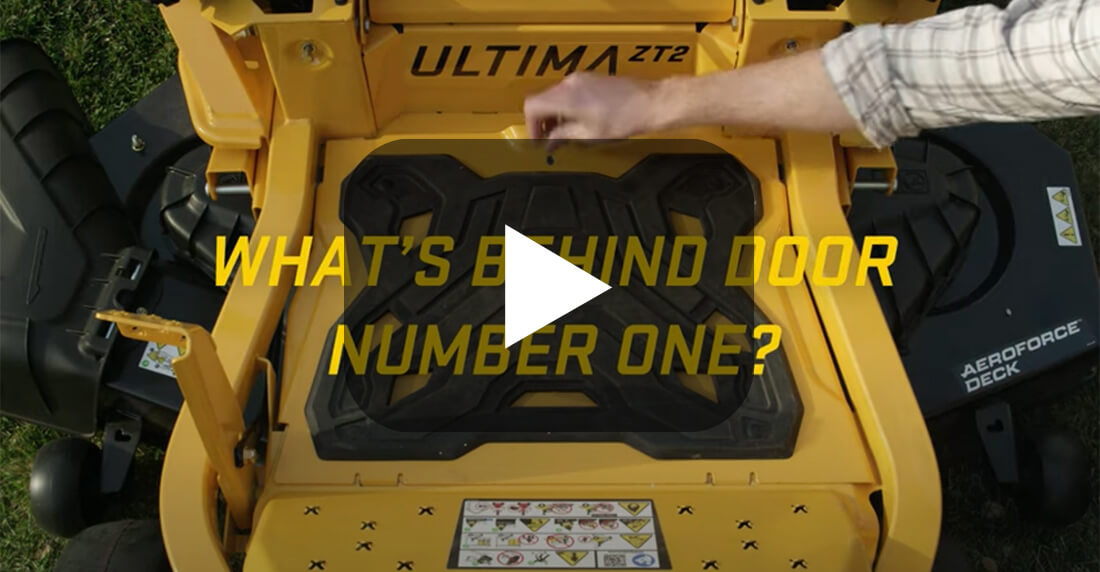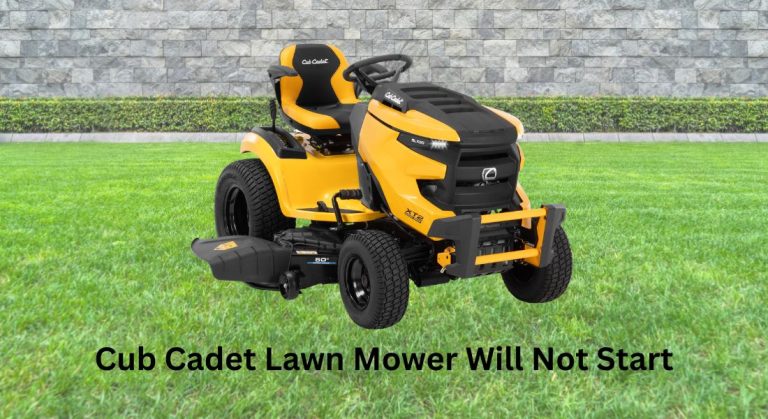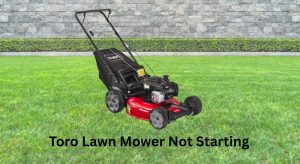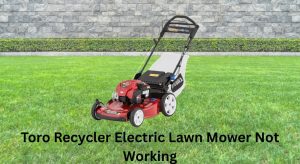Nothing is more frustrating than a beautiful day, a long to-do list, and a Cub Cadet lawn mower that will not start. Whether you have a push mower, self-propelled, or a Cub Cadet riding mower, the most common no-start issues often come down to fuel, spark, air, or safety switches. Quick fix: check your fuel shutoff valve (if equipped) is open, the choke is set correctly, and the battery connections are clean and tight. Often, a fresh spark plug and new fuel can get you mowing in minutes.
In this complete guide, you’ll learn the most common causes of a Cub Cadet won’t start issue and how to fix them step by step. We’ll cover both gas push mowers and riding mowers, walk through quick diagnostics, deeper repairs (carburetor cleaning, solenoid checks, safety switch testing), and preventive maintenance to keep your mower starting reliably all season.
Common Causes of a Cub Cadet That Won’t Start

- Old or contaminated fuel (varnish, water, ethanol phase separation)
- Incorrect choke/starting procedure
- Dirty carburetor or clogged jets
- Faulty spark plug or weak ignition coil
- Clogged air filter or blocked air intake
- Dead or weak battery (riding mowers)
- Loose or corroded battery cables/grounds (riding mowers)
- Bad starter solenoid or starter motor (riding mowers)
- Faulty safety switches (seat, brake/clutch, blade/PTO)
- Blown fuse, bad ignition switch, or wiring damage
- Fuel line blockage, faulty fuel cap vent, or bad fuel filter
- Flooded engine (wet spark plug, strong fuel smell)
- Low oil or oil sensor lockout (on some models)
How to Fix a Cub Cadet Lawn Mower That Will Not Start

Below are multiple methods, from fastest to more advanced. Choose gas walk-behind or riding mower paths where noted.
Method 1: Quick Start Checks (5–10 minutes)
Diagnosing the Issue
- Symptoms: Turns over but won’t fire, or no crank at all, or clicks only.
Fix Steps
- Verify fuel and switch positions:
– Ensure fuel shutoff valve is ON (parallel to fuel line).
– Set choke ON for cold start; throttle to fast.
– For riding mowers, ensure parking brake is engaged, PTO/blades OFF, and sit on the seat. - Check fuel quality:
– If fuel is older than 30–60 days, plan to drain and refill with fresh, ethanol-free fuel (if possible) plus fuel stabilizer. - Air filter:
– Remove air filter cover. If paper element is clogged or oil-soaked, remove it and try to start for 3–5 seconds without it. If it fires, replace the filter. - Spark plug inspection:
– Pull the plug wire and remove the spark plug.
– If wet/fuel-soaked, the engine is flooded. Dry the plug, set choke off, throttle wide open, and crank for 10–15 seconds to clear. Reinstall and try again.
– If carbon-fouled or worn, replace with the correct plug (common: Champion RJ19LM/J19LM for many walk-behinds, Champion RC12YC or equivalent for many Cub Cadet riders—verify in your manual). - Battery basics (riding mowers):
– Clean and tighten battery terminals. Look for green/white corrosion.
– Measure voltage: 12.6V+ is fully charged; 12.2V is ~50%; below 12.0V likely won’t crank. Charge to full before retesting.
Testing
- Try to start. If it cranks and fires briefly, fuel or air delivery may still be restricted. Move to Method 2 or 3.
Method 2: Fuel System Fixes (15–45 minutes)
Old fuel and varnish are top reasons a Cub Cadet will not start.
Diagnosing the Issue
- Symptoms: Starts only with starter fluid, surges/dies, no fuel in carburetor bowl, fuel leaking from carb.
Fix Steps
- Drain old fuel:
– Use a siphon pump to remove tank fuel.
– Dispose properly. Refill with fresh 87–91 octane fuel; ethanol-free preferred. - Replace/inspect fuel filter (if equipped):
– Follow the arrow for flow direction toward the carb.
– If filter looks dark, clogged, or air bubbles don’t pass, replace. - Check fuel cap vent:
– Run briefly with cap loosened. If it starts, the cap vent is blocked; replace the cap. - Inspect fuel lines:
– Look for cracks/collapses. Replace brittle lines. - Clean the carburetor (common on both walk-behind and riders):
– Shut off fuel valve and remove the carb bowl (10mm bolt on many models).
– Clean bowl and main jet. The main jet often has a tiny center hole—clear with a fine wire or carb spray.
– Replace bowl gasket if swollen/damaged.
– For stubborn varnish, remove the carb, strip jets/float/needle, and soak in carb cleaner. Reassemble carefully. - Primer bulb models (push mowers):
– Ensure the primer bulb isn’t cracked and actually pushes fuel. Replace if hardened or leaking.
Testing
- Prime or choke per manual and start. If it runs smoothly on fresh fuel after carb clean, the issue was fuel-related.
Method 3: Ignition and Spark System (10–30 minutes)
Diagnosing the Issue
- Symptoms: Strong fuel smell, plug stays dry or wet but never fires, no spark when testing.
Fix Steps
- Spark plug:
– Confirm correct plug type and gap (typically 0.028–0.030 inch; check your manual).
– Replace if fouled, cracked, or old. Tighten snugly and reconnect the boot firmly. - Spark test:
– Use an inline spark tester between plug and boot. Crank—look for bright, regular spark.
– No spark? Proceed below. - Safety/kill wire check (walk-behind):
– Many small engines use a kill wire to ground the coil. Disconnect the kill wire from the ignition coil temporarily and test spark again. If spark returns, the issue is the stop switch or wiring, not the coil. - Ignition coil (armature):
– Remove blower housing, inspect coil air gap to flywheel magnets (typical gap 0.010–0.014 inch; use a business card or spec shim). Replace coil if no spark with kill wire isolated. - For riders, check the interlocks:
– Seat, brake/clutch, and PTO switches can ground ignition. Test continuity and operation (see Method 5).
Testing
- Reinstall plug and try starting. If you have strong spark and fresh fuel, it should fire.
Method 4: Air Intake and Compression (5–20 minutes)
Diagnosing the Issue
- Symptoms: Filter packed with debris, backfiring through carb, low compression feel when pulling rope.
Fix Steps
- Air filter:
– Paper: Replace when dirty; do not wash.
– Foam pre-filter: Wash with mild soap and water, dry thoroughly, and lightly oil if specified. - Intake obstructions:
– Inspect intake tract and pre-cleaner screens. Clear mouse nests or debris. - Compression quick check:
– Pull starter rope—should feel consistent resistance. If very weak, perform a compression test (walk-behind engines often 60–90 psi with compression release; check your engine spec).
– Low compression may indicate valve issues or head gasket failure (advanced repair or pro help).
Testing
- With a new/clean filter and clear intake, attempt start again.
Method 5: Riding Mower Electrical and Safety Systems (20–60 minutes)
If your Cub Cadet riding mower will not start, electrical safety interlocks and the cranking circuit are common culprits.
Diagnosing the Issue
- Symptoms: No crank at all, click only, intermittent crank, or crank/no start.
Fix Steps
- Safety switches:
– Seat switch: Must be occupied for start/run on many models.
– Brake/clutch switch: Pedal must be fully depressed.
– PTO/blade switch: Must be OFF to crank.
– Test with a multimeter for continuity when actuated. Replace faulty switches. - Fuses:
– Locate the inline or panel fuse (commonly 15–20A). Replace if blown; investigate shorts if it blows again. - Ignition switch:
– Wiggle test: Turn key while gently wiggling. If intermittent, the switch may be bad. Check for 12V at the “S” terminal in Start position. - Starter solenoid:
– Listen for a click. If it clicks but doesn’t send power to the starter, test for 12V at the output terminal when cranking.
– Bridge the two large solenoid posts briefly with an insulated screwdriver as a test. If the engine cranks, the solenoid is suspect. Warning: Sparks possible—use caution. - Starter motor:
– If power reaches the starter and it doesn’t spin, bench test or replace the starter. - Ground and cables:
– Clean the chassis ground point and battery negative cable. Replace corroded or frayed cables. - Charging system check (after it runs):
– With engine running at full throttle, battery should read ~13.8–14.5V. If not, the regulator or stator may be faulty.
Testing
- After each fix, attempt to start. Verify the PTO is off, brake/seat switches made, and battery fully charged.
Method 6: Flooded Engine Recovery (5–10 minutes)
Diagnosing the Issue
- Symptoms: Strong fuel smell, wet spark plug, repeated failed starts using full choke.
Fix Steps
- Remove spark plug and dry it.
- Turn choke OFF, throttle to fast, and crank 10–15 seconds to clear cylinder.
- Reinstall plug; try to start with minimal or no choke.
- If flooding repeats, the carb needle/seat may leak—service the carb and check float height.
Testing
- Start and allow to warm up. Adjust choke off gradually once it’s running smoothly.
Method 7: Oil Level, Sensors, and Mechanical Locks (5–20 minutes)
Some engines will not start if oil is low or if a sensor detects a fault.
Diagnosing the Issue
- Symptoms: No start despite good spark and fuel, intermittent shutdowns on slopes.
Fix Steps
- Check oil level on level ground. Top up with the specified oil (e.g., SAE 10W-30 for many models; verify manual).
- If equipped with a low-oil sensor, correct level usually restores start. Do not bypass safety sensors for regular use.
- Check for hydro-lock (rare):
– If oil smells like gas or is overfilled, fuel may have leaked into the crankcase. Change oil and fix carb needle/seat.
Testing
- Start and monitor for smooth operation.
How to Prevent Future Starting Issues

- Use fresh, stabilized fuel; avoid storing fuel over 30–60 days.
- Run the engine dry or add stabilizer before off-season storage.
- Replace air filter and spark plug annually.
- Keep battery on a maintainer during winter (riding mowers).
- Clean debris from cooling fins and keep mower dry and covered.
- Service carburetor and fuel lines every 2–3 seasons if using ethanol fuels.
Pro Tips
- Use ethanol-free fuel (E0) or add a high-quality stabilizer if E10 is your only option.
- Prime/choke only as recommended. Over-choking floods the engine quickly.
- Keep a spare spark plug and inline fuel filter on hand—cheap, fast fixes.
- When diagnosing riders, use an inline spark tester and a 12V test light to trace power from key to solenoid to starter.
- Label safety switch connectors before removal to avoid miswiring.
- Replace gaskets and O-rings when opening the carb to prevent air leaks.
- After washing the mower, let it dry fully before starting to avoid wet ignition components.
When to Call a Professional
- Repeated no-spark after coil and wiring checks
- Low compression or suspected internal engine damage
- Persistent carb flooding despite rebuild
- Electrical shorts blowing fuses repeatedly
- Starter clutch/flywheel key issues after sudden blade impact
- Warranty coverage still active (don’t risk voiding)
What to look for:
– Factory-trained Cub Cadet or engine-brand certified technicians
– Transparent diagnostic fees and written estimates
– Genuine parts and warranty on repairs
Typical costs (varies by region/model):
– Carburetor clean/rebuild: $80–$180
– Ignition coil replacement: $70–$150
– Starter/solenoid replacement: $100–$250
– Full tune-up (plug, filter, oil, sharpening): $120–$220
Warranty notes:
– Use the correct oil, filters, and follow maintenance intervals to keep coverage intact.
– Keep receipts for parts and service as proof of maintenance.
FAQ
Q: My Cub Cadet clicks but won’t start. What’s wrong?
A: A single click usually points to a weak battery, corroded terminals, or a bad solenoid. Fully charge the battery (12.6V+), clean/tighten cables, and test for 12V at the solenoid’s output while cranking. If power reaches the starter and it doesn’t spin, the starter may be faulty.
Q: It runs on starter fluid but dies immediately. Why?
A: That means you have spark and compression, but no fuel delivery. Clean the carburetor, replace the fuel filter, ensure the fuel valve is open, and confirm the gas cap vent is not blocked.
Q: Which spark plug does my Cub Cadet use?
A: Common plugs include Champion RJ19LM/J19LM (walk-behind) and Champion RC12YC (riders), but always verify with your engine model (Briggs & Stratton, Kohler, or Kawasaki) and manual for the exact part number and gap.
Q: Do I need to use a fuel stabilizer?
A: Yes, if fuel will sit more than 30 days. Stabilizer prevents oxidation and helps reduce varnish that clogs jets, especially with ethanol blends.
Q: My mower cranks but there’s no spark. What should I check?
A: Test with an inline spark tester. If no spark, isolate the coil by disconnecting the kill wire; if spark returns, inspect the stop switch and safety circuits. If still no spark, set coil air gap correctly or replace the coil.
Q: Why does my mower only start with the gas cap loose?
A: The cap’s vent is blocked, creating a vacuum that starves fuel flow. Replace the fuel cap.
Q: How often should I replace the air filter and spark plug?
A: Replace the air filter every season or 25 hours (more often in dusty conditions) and the spark plug annually or every 100 hours, per your engine’s manual.
Q: Can low oil prevent starting?
A: On models with a low-oil shutdown, yes. Always check and correct the oil level. If oil is fuel-contaminated or overfull, change it and repair the carb float needle.
Alternative Solutions
Sometimes repeated carburetor issues make replacement or upgrades sensible.
| Solution | Pros | Cons | Best For |
|---|---|---|---|
| Carburetor rebuild | Cheapest parts, restores OEM | Time-consuming, requires cleaning | DIYers comfortable with small parts |
| New aftermarket carb | Fast swap, often under $40–$80 | Varies in quality, may need fine-tuning | Quick, budget-friendly fix |
| Ethanol-free fuel (E0) | Reduces varnish, easier starts | Higher cost, limited availability | Seasonal users and storage |
| Fuel shutoff + run bowl dry | Prevents flooding/varnish | Extra step after mowing | Long-term storage reliability |
Get Your Cub Cadet Working Again
Following this guide, you now have multiple solutions to fix a Cub Cadet lawn mower that will not start:
– Quick start checks: choke, fuel, spark plug, air filter
– Fuel system service: fresh gas, filter and line checks, carburetor cleaning
– Ignition and safety circuits: coil gap, switches, battery, solenoid, starter
– Preventive steps: stabilized fuel, annual tune-ups, battery maintenance
Don’t let a no-start derail your weekend. Try these methods in order, from simplest to more advanced, and you’ll have your Cub Cadet back to cutting clean, even lines in no time.
Have you successfully fixed your Cub Cadet lawn mower? Share your results or model details in the comments below so we can help other readers with the same issue. Found this guide helpful? Bookmark it for quick reference before your next mow.





